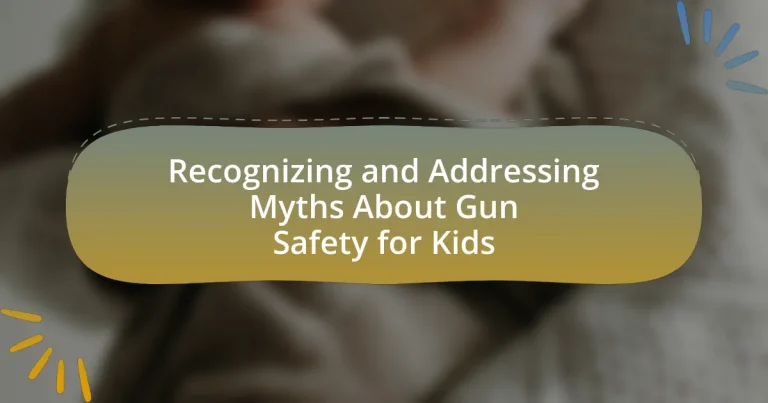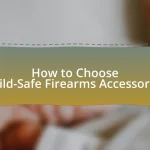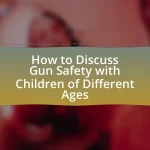The article focuses on recognizing and addressing common myths about gun safety for children. It highlights misconceptions such as the belief that children will not touch firearms if instructed not to and that gun locks are unnecessary if guns are stored out of reach. The persistence of these myths is attributed to misinformation, cultural beliefs, and media portrayals, which can lead to dangerous situations for children. The article emphasizes the importance of secure storage, education, and open conversations about gun safety to promote responsible behavior and reduce the risk of accidental shootings among children. Additionally, it discusses effective community programs and initiatives that support families in gun safety education.
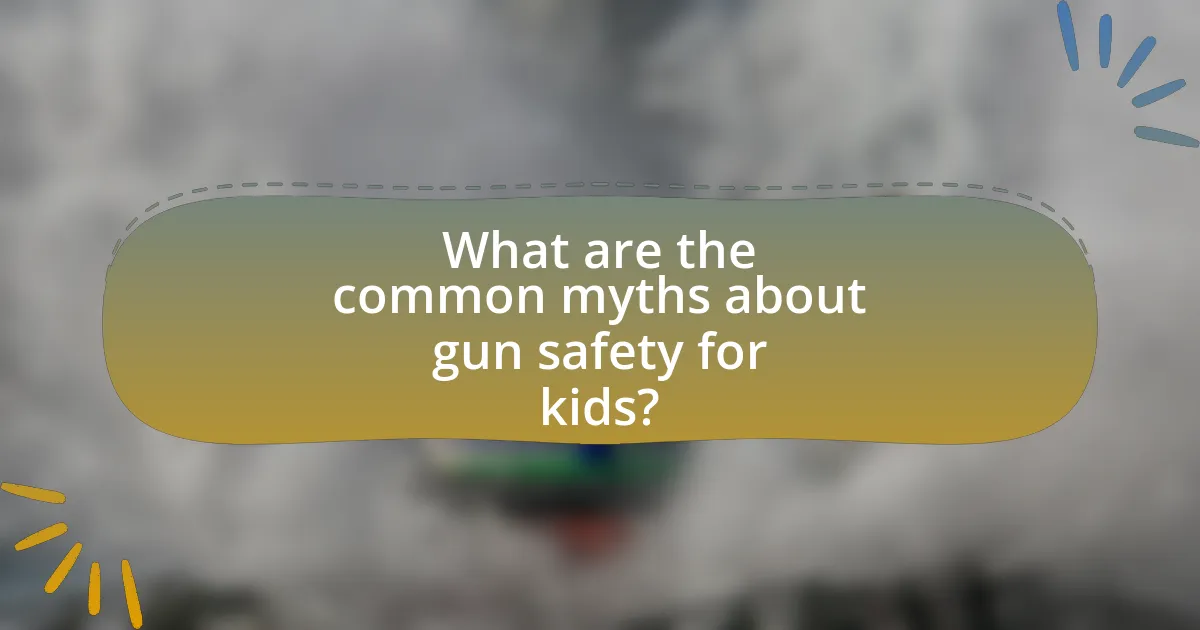
What are the common myths about gun safety for kids?
Common myths about gun safety for kids include the belief that children will not touch a gun if they are told not to, and that gun locks or safes are unnecessary if the firearm is stored out of reach. Research indicates that children are naturally curious and may seek out firearms despite warnings, as evidenced by a study from the American Academy of Pediatrics, which found that nearly 1 in 3 children reported handling a gun without their parents’ knowledge. Additionally, the National Safety Council emphasizes that secure storage methods, such as gun locks and safes, are essential for preventing accidental shootings, regardless of the firearm’s location.
Why do these myths persist in society?
Myths about gun safety for kids persist in society primarily due to misinformation and cultural beliefs surrounding firearms. These misconceptions are often reinforced by media portrayals, anecdotal experiences, and a lack of comprehensive education on gun safety. For instance, studies indicate that many parents underestimate the risks associated with unsecured firearms in homes, leading to a false sense of security. Additionally, societal norms and peer influences can perpetuate these myths, as individuals may rely on shared beliefs rather than factual information. This combination of factors creates an environment where myths can thrive, ultimately impacting the safety and well-being of children.
What role does media play in shaping perceptions of gun safety?
Media plays a significant role in shaping perceptions of gun safety by influencing public opinion and awareness through coverage and narratives. Research indicates that media portrayals often emphasize gun violence, which can lead to heightened fear and misconceptions about gun safety, particularly among parents regarding their children’s exposure to firearms. For instance, a study published in the journal “Pediatrics” found that increased media coverage of gun-related incidents correlates with a rise in parental concerns about gun safety in homes, regardless of actual statistics on gun accidents. This suggests that the media’s focus on sensational stories can distort the reality of gun safety, leading to misconceptions that may not align with factual data on firearm-related injuries and deaths among children.
How do cultural attitudes influence beliefs about gun safety?
Cultural attitudes significantly shape beliefs about gun safety by influencing perceptions of risk, responsibility, and the role of firearms in society. For instance, in cultures where gun ownership is viewed as a fundamental right, individuals may prioritize personal freedom over safety concerns, leading to a belief that gun safety education is less critical. Conversely, in cultures that emphasize collective safety and regulation, there is often a stronger advocacy for comprehensive gun safety measures and education. Research indicates that communities with higher rates of gun violence tend to adopt more cautious attitudes towards firearms, advocating for stricter safety protocols and training. This dynamic illustrates how cultural context directly impacts the prioritization of gun safety practices and beliefs.
What are the most prevalent misconceptions regarding gun safety for children?
The most prevalent misconceptions regarding gun safety for children include the beliefs that children cannot accidentally discharge a firearm, that simply hiding guns keeps them safe, and that children will always report finding a gun to an adult. Research indicates that children as young as three can pull the trigger of a firearm, highlighting the danger of assuming they lack the physical ability to do so. Additionally, studies show that 73% of children who find a gun will handle it without telling an adult, contradicting the belief that they will always seek help. These misconceptions can lead to inadequate safety measures, increasing the risk of accidental shootings among children.
How does the belief that “kids are naturally safe around guns” affect behavior?
The belief that “kids are naturally safe around guns” leads to increased risk-taking behavior among both children and adults. When caregivers assume that children can handle firearms without proper supervision or education, they may neglect to implement necessary safety measures, such as secure storage or teaching gun safety. Research indicates that approximately 1.7 million children live in homes with loaded and unlocked firearms, which correlates with higher rates of accidental shootings and suicides involving guns. This belief fosters a false sense of security, ultimately contributing to dangerous situations where children may access firearms without understanding the associated risks.
What misconceptions exist about the effectiveness of gun locks and safes?
Misconceptions about the effectiveness of gun locks and safes include the belief that they are foolproof solutions for preventing unauthorized access to firearms. Many people assume that gun locks and safes completely eliminate the risk of accidental discharges or theft, but studies indicate that they can be bypassed or defeated, especially if not used correctly. For instance, a report from the National Institute of Justice found that while gun safes significantly reduce the likelihood of unauthorized access, they are not impervious to determined individuals, particularly if they are not properly secured or if the combination is known. Additionally, some users mistakenly believe that simply locking a gun away is sufficient, neglecting the importance of ongoing education about safe storage practices and the need for regular checks on the locking mechanisms.

How can parents and guardians address these myths?
Parents and guardians can address myths about gun safety for kids by educating themselves and their children on safe practices and the realities of gun ownership. They should engage in open discussions about firearms, emphasizing the importance of safety measures such as storing guns unloaded and locked away, which research shows significantly reduces the risk of accidental shootings among children. Additionally, parents can utilize resources from organizations like the National Safety Council, which provides guidelines and educational materials on gun safety. By fostering an environment of awareness and responsibility, parents can dispel misconceptions and promote a culture of safety regarding firearms.
What strategies can be employed to educate children about gun safety?
To educate children about gun safety, parents and educators can employ strategies such as interactive training programs, age-appropriate discussions, and the use of educational materials. Interactive training programs, like the Eddie Eagle GunSafe Program, teach children to recognize the dangers of firearms and the importance of telling an adult if they encounter a gun. Age-appropriate discussions involve open conversations about gun safety, emphasizing the message that guns are not toys and should never be handled without adult supervision. Educational materials, including books and videos that illustrate safe behaviors around firearms, can reinforce these lessons. Research indicates that structured educational interventions significantly reduce the likelihood of accidental shootings among children, highlighting the effectiveness of these strategies.
How can open conversations about guns promote safety awareness?
Open conversations about guns can promote safety awareness by facilitating education and understanding of firearm risks and safety practices. Engaging in dialogue allows individuals, especially children, to learn about the importance of gun safety rules, such as treating every gun as if it is loaded and never pointing it at anything they do not intend to shoot. Research indicates that children who are educated about gun safety are less likely to engage in risky behaviors around firearms. For instance, a study published in the journal “Pediatrics” found that children who received gun safety training were significantly more likely to demonstrate safe behaviors when encountering a firearm. Therefore, open conversations not only dispel myths surrounding gun safety but also empower individuals with the knowledge needed to make informed decisions, ultimately enhancing community safety.
What resources are available for teaching kids about gun safety?
Resources available for teaching kids about gun safety include the Eddie Eagle GunSafe Program, the National Rifle Association’s (NRA) “Refuse to Be a Victim” program, and the American Academy of Pediatrics’ guidelines on firearm safety. The Eddie Eagle program provides educational materials and animated videos aimed at children, emphasizing the importance of not touching guns and seeking adult help. The NRA’s program offers workshops and resources for parents and educators to teach children about personal safety and awareness around firearms. The American Academy of Pediatrics advocates for safe storage practices and provides literature that stresses the importance of discussing gun safety with children. These resources are designed to effectively educate children about the dangers of firearms and promote safe behaviors.
Why is it important to debunk these myths?
Debunking myths about gun safety for kids is crucial to ensure their protection and promote responsible behavior. Misconceptions can lead to dangerous situations, as they may encourage negligence or a false sense of security regarding firearms. For instance, the belief that children are not capable of accessing guns can result in inadequate storage practices, increasing the risk of accidental shootings. According to the Centers for Disease Control and Prevention, in 2019, nearly 400 children aged 0-14 died from unintentional firearm injuries in the United States, highlighting the real dangers associated with these myths. By addressing and correcting these misconceptions, parents and caregivers can foster a safer environment and encourage informed discussions about gun safety.
How can misinformation lead to dangerous situations for children?
Misinformation can lead to dangerous situations for children by creating false beliefs about gun safety, which may result in improper handling or exposure to firearms. For instance, if children are misled to think that guns are toys or that they are always unloaded, they may engage with firearms inappropriately, increasing the risk of accidental shootings. Research from the American Academy of Pediatrics indicates that children who are not educated about the dangers of guns are more likely to encounter them unsafely, highlighting the critical need for accurate information regarding gun safety.
What impact does myth-busting have on community safety?
Myth-busting significantly enhances community safety by dispelling false beliefs that can lead to dangerous behaviors regarding gun safety for children. For instance, research indicates that misconceptions about the prevalence of child gun accidents can result in inadequate safety measures being taken by parents and guardians. By providing accurate information, such as the fact that proper storage of firearms reduces the risk of accidental shootings by 73%, myth-busting encourages responsible gun ownership and promotes proactive safety practices within the community. This informed approach ultimately fosters a safer environment for children and reduces the likelihood of tragic incidents.
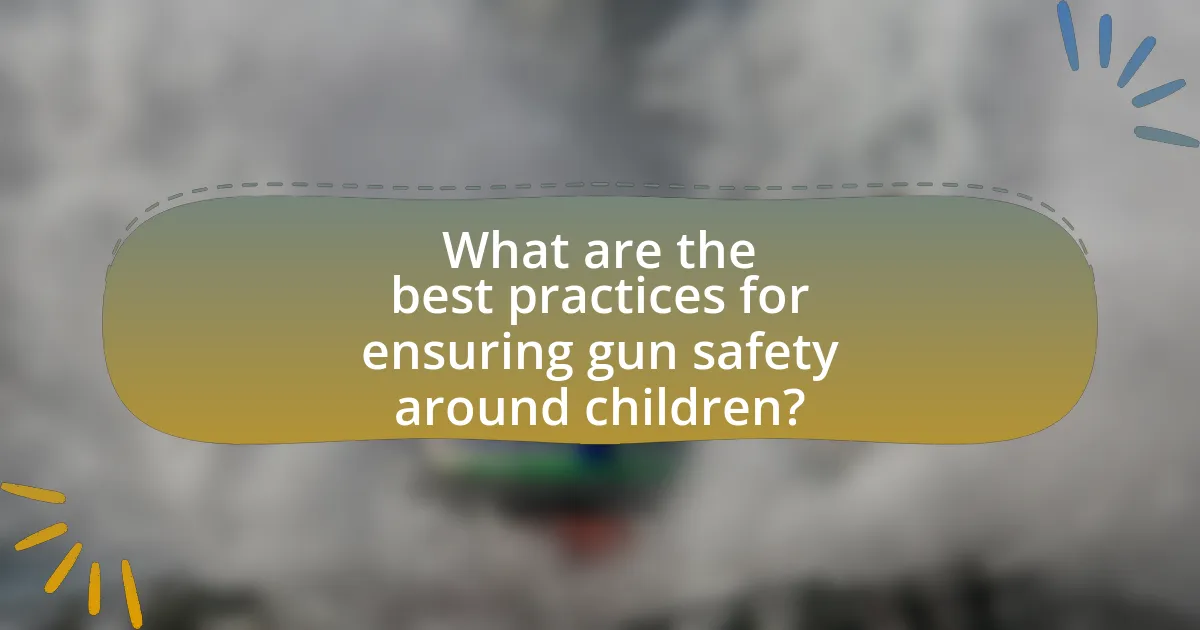
What are the best practices for ensuring gun safety around children?
The best practices for ensuring gun safety around children include securely storing firearms, educating children about gun safety, and supervising children at all times. Secure storage involves using gun safes or lockboxes to prevent unauthorized access, as studies show that 73% of children who live in homes with firearms report knowing where the guns are stored. Educating children about the dangers of guns and teaching them to never touch a firearm without adult supervision is crucial; the National Rifle Association emphasizes that children should be taught to “stop, don’t touch, run away, and tell a grown-up” if they encounter a gun. Finally, constant supervision ensures that children are not left alone in environments where firearms are present, significantly reducing the risk of accidental shootings.
How can parents create a safe environment regarding firearms?
Parents can create a safe environment regarding firearms by securely storing guns and ammunition in locked containers, ensuring that children cannot access them. Research indicates that approximately 73% of children who live in homes with firearms know where the guns are stored, highlighting the importance of proper storage. Additionally, parents should educate their children about the dangers of firearms and establish clear rules regarding gun safety. Studies show that children who receive gun safety education are less likely to engage in unsafe behaviors around firearms.
What are the key components of a comprehensive gun safety plan?
A comprehensive gun safety plan includes secure storage, education, communication, and regular safety checks. Secure storage involves using gun safes or lockboxes to prevent unauthorized access, particularly by children. Education focuses on teaching children about the dangers of firearms and the importance of safety measures, which can reduce accidental shootings. Communication between parents and children about gun safety fosters an environment where children feel comfortable discussing firearms. Regular safety checks ensure that safety measures are consistently followed and that firearms remain secure. These components collectively contribute to reducing the risk of firearm-related incidents, particularly among children.
How can regular safety drills enhance children’s understanding of gun safety?
Regular safety drills enhance children’s understanding of gun safety by providing them with practical, hands-on experience in responding to potential firearm-related situations. These drills teach children critical skills such as recognizing the presence of a gun, understanding the importance of not touching it, and knowing how to seek help from an adult. Research indicates that children who participate in regular safety drills demonstrate improved knowledge and retention of gun safety rules compared to those who do not engage in such practices. For instance, a study published in the Journal of Pediatric Psychology found that children exposed to structured safety training showed a 50% increase in their ability to identify safe behaviors around firearms. This evidence underscores the effectiveness of regular drills in reinforcing essential safety concepts and reducing the likelihood of accidental injuries.
What role do community programs play in promoting gun safety for kids?
Community programs play a crucial role in promoting gun safety for kids by providing education, resources, and support to families. These programs often include workshops, safety courses, and community events that teach children about the dangers of firearms and the importance of responsible behavior around guns. For instance, the National Shooting Sports Foundation’s “Project ChildSafe” has distributed over 38 million gun safety kits, which include educational materials aimed at children and parents, emphasizing the need for secure firearm storage and awareness. By engaging communities, these programs help to foster a culture of safety and responsibility, significantly reducing the risk of accidental shootings among children.
How can local organizations support families in gun safety education?
Local organizations can support families in gun safety education by providing accessible training programs and resources tailored to community needs. These organizations can offer workshops that teach safe storage practices, the importance of discussing gun safety with children, and how to recognize and address myths surrounding firearms. For instance, the National Shooting Sports Foundation reports that education initiatives can significantly reduce accidental shootings among children, highlighting the effectiveness of community-based programs in promoting responsible gun ownership.
What initiatives have proven effective in reducing gun-related accidents among children?
Initiatives that have proven effective in reducing gun-related accidents among children include comprehensive gun safety education programs and the implementation of safe storage laws. Research indicates that programs like the Eddie Eagle GunSafe Program, which teaches children to avoid guns and seek adult help, have significantly decreased the incidence of unintentional firearm injuries among children. Additionally, states that have enacted safe storage laws, requiring firearms to be securely stored when not in use, have reported lower rates of gun-related accidents involving children. For example, a study published in the American Journal of Public Health found that states with such laws experienced a 13% reduction in unintentional firearm deaths among children.
What practical tips can parents implement to ensure gun safety for their kids?
Parents can implement several practical tips to ensure gun safety for their kids, including securely storing firearms in locked cabinets or safes, using gun locks, and keeping ammunition stored separately. Research indicates that proper storage can significantly reduce the risk of accidental shootings; for instance, a study published in the American Journal of Public Health found that homes with locked firearms had a 73% lower risk of unintentional firearm deaths among children. Additionally, parents should educate their children about the dangers of guns, encouraging open discussions and teaching them to never touch a firearm without adult supervision. This proactive approach can help demystify firearms and promote responsible behavior.
